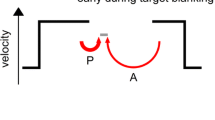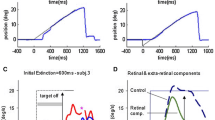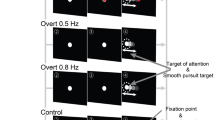Abstract
Alterations in sensorimotor processing and predictive mechanisms have both been proposed as the primary cause of eye tracking deficits in schizophrenia. 20 schizophrenia patients and 20 healthy controls were assessed on blocks of predictably moving visual targets at constant speeds of 10, 15 or 30°/s. To assess internal drive to the eye movement system based on predictions about the ongoing target movement, targets were blanked off for either 666 or 1,000 ms during the ongoing pursuit movement in additional conditions. Main parameters of interest were eye deceleration after extinction of the visual target and residual eye velocity during blanking intervals. Eye deceleration after target extinction, reflecting persistence of predictive signals, was slower in patients than in controls, implying greater rather than diminished utilization of predictive mechanisms for pursuit in schizophrenia. Further, residual gain was not impaired in patients indicating a basic integrity of internal predictive models. Pursuit velocity gain in patients was reduced in all conditions with visible targets replicating previous findings about a sensorimotor transformation deficit in schizophrenia. A pattern of slower eye deceleration and unimpaired residual gain during blanking intervals implies greater adherence to top-down predictive models for pursuit tracking in schizophrenia. This suggests that predictive modeling is relatively intact in schizophrenia and that the primary cause of abnormal visual pursuit is impaired sensorimotor transformation of the retinal error signal needed for the maintenance of accurate visually driven pursuit. This implies that disruption in extrastriate and sensorimotor systems rather than frontostriatal predictive mechanisms may underlie this widely reported endophenotypes for schizophrenia.



Similar content being viewed by others
References
American Psychiatric Association (1994) Diagnostic and statistical manual of mental disorders DSM-IV. American Psychiatric Press, Washington DC
Arolt V, Lencer R, Nolte A, Pinnow M, Schwinger E (1996) Eye tracking dysfunction in families with multiple cases of schizophrenia. Eur Arch Psychiatry Clin Neurosci 246:175–181
Barnes GR, Asselman PT (1991) The mechanism of prediction in human smooth pursuit eye movements. J Physiol 439:439–461
Barnes GR, Collins CJ (2008) Evidence for a link between the extra-retinal component of random-onset pursuit and the anticipatory pursuit of predictable object motion. J Neurophysiol 100:1135–1146
Becker W, Fuchs AF (1985) Prediction in the oculomotor system: smooth pursuit during transient disappearance of a visual target. Exp Brain Res 57:562–575
Bennett SJ, Barnes GR (2003) Human ocular pursuit during the transient disappearance of a visual target. J Neurophysiol 90:2504–2520
Bennett SJ, Barnes GR (2006) Combined smooth and saccadic ocular pursuit during the transient occlusion of a moving visual object. Exp Brain Res 168:313–321
Burke MR, Barnes GR (2007) Sequence learning in two-dimensional smooth pursuit eye movements in humans. J Vis 7:5
Butler PD, Silverstein SM, Dakin SC (2008) Visual perception and its impairment in schizophrenia. Biol Psychiatry 64:40–47
Chen Y, Nakayama K, Levy D, Matthysse S, Holzman P (2003) Processing of global, but not local, motion direction is deficient in schizophrenia. Schizophr Res 61:215–227
Clementz BA, McDowell JE (1994) Smooth pursuit in schizophrenia: abnormalities of open- and closed-loop responses. Psychophysiology 31:79–86
First MB, Gibbon MSRL, Williams JBW, Benjamin LS (1997) Structured clinical interview for DSM-IV axis II personality disorders (SCID-II). American Psychiatric Press, Washington DC
Fukushima K, Yamanobe T, Shinmei Y, Fukushima J (2002) Predictive responses of periarcuate pursuit neurons to visual target motion. Exp Brain Res 145:104–120
Haraldsson HM, Ettinger U, Magnusdottir BB, Sigmundsson T, Sigurdsson E, Petursson H (2008) Eye movement deficits in schizophrenia: investigation of a genetically homogenous Icelandic sample. Eur Arch Psychiatry Clin Neurosci 258:373–383
Hong LE, Turano KA, O’Neill H, Hao L, Wonodi I, McMahon RP et al (2008) Refining the predictive pursuit endophenotype in schizophrenia. Biol Psychiatry 63:458–464
Hong LE, Turano KA, O’Neill HB, Hao L, Wonodi I, McMahon RP et al (2009) Is motion perception deficit in schizophrenia a consequence of eye-tracking abnormality? Biol Psychiatry 65:1079–1085
Hutton SB, Crawford TJ, Gibbins H, Cuthbert I, Barnes TR, Kennard C et al (2001) Short and long term effects of antipsychotic medication on smooth pursuit eye tracking in schizophrenia. Psychopharmacology 157:284–291
Ilg UJ (2008) The role of areas MT and MST in coding of visual motion underlying the execution of smooth pursuit. Vision Res 48:2062–2069
Kay SR, Fiszbein A, Opler LA (1987) The positive and negative syndrome scale (PANSS) for schizophrenia. Schizophr Bull 13:261–276
Lencer R, Sprenger A, Trillenberg P (2011) Mechanisms of prediction in patients with psychosis. Eur Arch Psychiatry Clin Neurosci 261:93
Lencer R, Keedy SK, Reilly JL, McDonough BE, Harris MS, Sprenger A et al (2011) Altered transfer of visual motion information to parietal association cortex in untreated first-episode psychosis: implications for pursuit eye tracking. Psychiatry Res 194:30–38
Lencer R, Nagel M, Sprenger A, Zapf S, Erdmann C, Heide W et al (2004) Cortical mechanisms of smooth pursuit eye movements with target blanking. An fMRI study. Eur J Neurosci 19:1430–1436
Lencer R, Reilly JL, Harris MS, Sprenger A, Keshavan MS, Sweeney JA (2010) Sensorimotor transformation deficits for smooth pursuit in first-episode affective psychoses and schizophrenia. Biol Psychiatry 67:217–223
Lencer R, Sprenger A, Harris MS, Reilly JL, Keshavan MS, Sweeney JA (2008) Effects of second-generation antipsychotic medication on smooth pursuit performance in antipsychotic-naive schizophrenia. Arch Gen Psychiatry 65:1146–1154
Levy DL, Holzman PS, Matthysse S, Mendell NR (1993) Eye tracking dysfunction and schizophrenia: a critical perspective. Schizophr Bull 19:461–536
Lindner A, Thier P, Kircher TT, Haarmeier T, Leube DT (2005) Disorders of agency in schizophrenia correlate with an inability to compensate for the sensory consequences of actions. Curr Biol 15:1119–1124
Lisberger SG (2010) Visual guidance of smooth-pursuit eye movements: sensation, action, and what happens in between. Neuron 66:477–491
Nagel M, Sprenger A, Nitschke M, Zapf S, Heide W, Binkofski F et al (2007) Different extraretinal neuronal mechanisms of smooth pursuit eye movements in schizophrenia: an fMRI study. Neuroimage 34:300–309
O’Driscoll GA, Callahan BL (2008) Smooth pursuit in schizophrenia: a meta-analytic review of research since 1993. Brain Cogn 68:359–370
Robinson DA, Gordon JL, Gordon SE (1986) A model of the smooth pursuit eye movement system. Biol Cybern 55:43–57
Sheehan DV, Lecrubier Y, Sheehan KH, Amorim P, Janavs J, Weiller E et al (1998) The mini-international neuropsychiatric interview (M.I.N.I.): the development and validation of a structured diagnostic psychiatric interview for DSM-IV and ICD-10. J Clin Psychiatry 59(suppl 20):22–33
Sprenger A, Trillenberg P, Pohlmann J, Herold K, Lencer R, Helmchen C (2011) The role of prediction and anticipation on age-related effects on smooth pursuit eye movements. Ann N Y Acad Sci 1233:168–176
Sweeney JA, Luna B, Srinivasagam NM, Keshavan MS, Schooler NR, Haas GL et al (1998) Eye tracking abnormalities in schizophrenia: evidence for dysfunction in the frontal eye fields. Biol Psychiatry 44:698–708
Thaker GK (2008) Neurophysiological endophenotypes across bipolar and schizophrenia psychosis. Schizophr Bull 34:760–773
Thaker GK, Ross DE, Buchanan RW, Adami HM, Medoff DR (1999) Smooth pursuit eye movements to extra-retinal motion signals: deficits in patients with schizophrenia. Psychiatry Res 88:209–219
Thaker GK, Ross DE, Cassady SL, Adami HM, LaPorte D, Medoff DR et al (1998) Smooth pursuit eye movements to extraretinal motion signals: deficits in relatives of patients with schizophrenia. Arch Gen Psychiatry 55:830–836
Trillenberg P, Heide W, Junghanns K, Blankenburg M, Arolt V, Kompf D (1998) Target anticipation and impairment of smooth pursuit eye movements in schizophrenia. Exp Brain Res 120:316–324
van den Berg AV (1988) Human smooth pursuit during transient perturbations of predictable and unpredictable target movement. Exp Brain Res 72:95–108
van den Berg AV, Collewijn H (1987) Voluntary smooth eye movements with foveally stabilized targets. Exp Brain Res 68:195–204
Wang J, Brown R, Dobkins KR, McDowell JE, Clementz BA (2010) Diminished parietal cortex activity associated with poor motion direction discrimination performance in schizophrenia. Cereb Cortex 20:1749–1755
Acknowledgments
This study was supported by the University Luebeck (grant J06/2002) and by a Feodor Lynen Fellowship (RL) and a Research Award (JAS) provided by the Alexander von Humboldt Foundation, Germany. No funding source played any role in the collection, analysis, interpretation or publication of data.
Conflict of interest
None.
Author information
Authors and Affiliations
Corresponding author
Electronic supplementary material
Below is the link to the electronic supplementary material.
S2: Triangular pursuit target of ±15° amplitude and 10°/s. Example video, target dot was computed online with high resolution. Supplementary material 2 (AVI 590 kb)
S3: Triangular pursuit target of ±15° amplitude and 10°/s with a 1000-ms blanking interval. Example video, target dot was computed online with high resolution. Supplementary material 3 (AVI 547 kb)
Rights and permissions
About this article
Cite this article
Sprenger, A., Trillenberg, P., Nagel, M. et al. Enhanced top-down control during pursuit eye tracking in schizophrenia. Eur Arch Psychiatry Clin Neurosci 263, 223–231 (2013). https://doi.org/10.1007/s00406-012-0332-9
Received:
Accepted:
Published:
Issue Date:
DOI: https://doi.org/10.1007/s00406-012-0332-9




